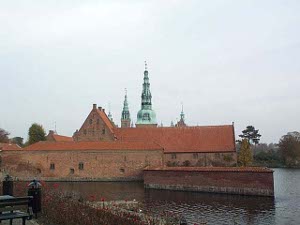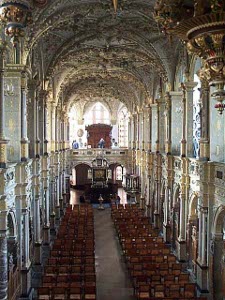One way to develop a sense of the long history of Europe is to note the  Castle seen from Hillebrod
number of Great Fires and Major Fires over the last 500 years. Churches, castles, entire towns have been built and re-built and re-re-built, and it's not always a case of warfare. Often enough it's just the natural result of too many wooden structures with open fires for cooking and lighting and wholly inadequate firefighting forces. In the case of Fredericksborg Slot, or Castle, we don't know what caused the fire of 1859, and it's not that important because the castle, originally built to the instructions of King Christian IV in 1604, was rebuilt to the original specifications, so for all practical purposes we have here a Renaissance Palace.
Castle seen from Hillebrod
number of Great Fires and Major Fires over the last 500 years. Churches, castles, entire towns have been built and re-built and re-re-built, and it's not always a case of warfare. Often enough it's just the natural result of too many wooden structures with open fires for cooking and lighting and wholly inadequate firefighting forces. In the case of Fredericksborg Slot, or Castle, we don't know what caused the fire of 1859, and it's not that important because the castle, originally built to the instructions of King Christian IV in 1604, was rebuilt to the original specifications, so for all practical purposes we have here a Renaissance Palace.
We took a train from the Copenhagen station, accidentally boarding a  Sausage shop
smoking car. Oh, well, it was a 45-minute ride, would we even notice? Soon every vacant seat was filled and everybody was puffing, dropping ashes into the little metal waste containers at each seat. Several travelers were headed out for a day of fishing, with fishing rods and wicker baskets full of lunch. For the first time in our travels on local trains, we were visited by the conductor checking tickets; everybody was able to produce the proper paper.
Sausage shop
smoking car. Oh, well, it was a 45-minute ride, would we even notice? Soon every vacant seat was filled and everybody was puffing, dropping ashes into the little metal waste containers at each seat. Several travelers were headed out for a day of fishing, with fishing rods and wicker baskets full of lunch. For the first time in our travels on local trains, we were visited by the conductor checking tickets; everybody was able to produce the proper paper.
We walked down the hill from the train station into the small town of Hillebrod which was full of shoppers and families enjoying a pleasant Saturday morning. A small market had been set up on a plaza across from the Castle. The  First we crossed the moat
main street is a pedestrian-only street, at least in the morning (coming back, we found a determined woman easing her car into the crowds), where most of the shops seem to be selling their Fall clothing. As we took the photo of the sausage shop, a man came out next door, saw our camera, and gave us a big bow and grin.
First we crossed the moat
main street is a pedestrian-only street, at least in the morning (coming back, we found a determined woman easing her car into the crowds), where most of the shops seem to be selling their Fall clothing. As we took the photo of the sausage shop, a man came out next door, saw our camera, and gave us a big bow and grin.
At the castle end of town, you cross a wide bridge, and then begin the approach. First a moat, then a large gate, then another entrance into a big cobbled courtyard, and then you begin to get within the castle walls. Throughout our visit, we were struck by the idea that the Danes truly believe their monarchy belongs to them. Castles, history, and all, Kings, Queens, it's all part of daily life. This castle was not heavily guarded; it was set out as  Then up to the outer gate
a National Museum of Danish History, with explanatory pieces of paper in each room, written in Danish and English. Families with children were abundant, and everybody generally obeyed the signs that said please don't touch, although there was a harp on display in the music room, and just before we entered we mysteriously heard the sound of a harp string being plucked.
Then up to the outer gate
a National Museum of Danish History, with explanatory pieces of paper in each room, written in Danish and English. Families with children were abundant, and everybody generally obeyed the signs that said please don't touch, although there was a harp on display in the music room, and just before we entered we mysteriously heard the sound of a harp string being plucked.
The castle church is used by the town as its parish church; its walls are lined with ceremonial shields of knights inducted into Denmark's highest orders. It seemed to us that the Order of Dannebrog is generally given to Danes, while the Order of the Elephant is generally awarded to royalty and heads of state of  Through the inner gate
foreign countries. We looked through the shields of the Order of the Elephant and spotted those of Churchill, Eisenhower, Tito, and Nils Bohr (an exception to the rule). The altarpiece and pulpit, made out of ebony and inlaid silver, are gorgeous, and there is an enclosed pew opposite the pulpit for the king.
Through the inner gate
foreign countries. We looked through the shields of the Order of the Elephant and spotted those of Churchill, Eisenhower, Tito, and Nils Bohr (an exception to the rule). The altarpiece and pulpit, made out of ebony and inlaid silver, are gorgeous, and there is an enclosed pew opposite the pulpit for the king.
The rest of the castle/museum contains the accumulated furniture, objets d'art, royal portraits, armor, and tapestries from the last several hundred years. There are some lovely surprises, like an inlaid cabinet in which mirrors have been placed so that the interior looks like a stage set, with corridors leading off to the sides. For the most part, though, we thought the building itself was most interesting, with its set-pieces of Great Events In Danish  Inside the royal chapel
History painted with more accuracy than beauty.
Inside the royal chapel
History painted with more accuracy than beauty.
To complete the exhibit there is a portrait gallery of Great Danes ot the twentieth century: many fields of endeavour are represented, from veterinary medicine to zoology to the editor of the first dictionary of the Danish Language (her field is described as "runology") to actors and musicians and writers, along with resistance fighters from WW II.
One very appealing part of this visit was the fact that we had escaped tour groups. For most of our visit we saw only a few other families in these large rooms. For a small Danish child, this would be a pleasant place to start learning history; there are lots of huge rooms where you can hide under a bench, or slide across the floor until dad stops you, and there are workbooks with questions that you and your parents can answer. We passed two or three enjoyable hours touring Fredericksborg Slot.
 Castle seen from Hillebrod
number of Great Fires and Major Fires over the last 500 years. Churches, castles, entire towns have been built and re-built and re-re-built, and it's not always a case of warfare. Often enough it's just the natural result of too many wooden structures with open fires for cooking and lighting and wholly inadequate firefighting forces. In the case of Fredericksborg Slot, or Castle, we don't know what caused the fire of 1859, and it's not that important because the castle, originally built to the instructions of King Christian IV in 1604, was rebuilt to the original specifications, so for all practical purposes we have here a Renaissance Palace.
Castle seen from Hillebrod
number of Great Fires and Major Fires over the last 500 years. Churches, castles, entire towns have been built and re-built and re-re-built, and it's not always a case of warfare. Often enough it's just the natural result of too many wooden structures with open fires for cooking and lighting and wholly inadequate firefighting forces. In the case of Fredericksborg Slot, or Castle, we don't know what caused the fire of 1859, and it's not that important because the castle, originally built to the instructions of King Christian IV in 1604, was rebuilt to the original specifications, so for all practical purposes we have here a Renaissance Palace.
 Sausage shop
Sausage shop First we crossed the moat
First we crossed the moat Then up to the outer gate
Then up to the outer gate Through the inner gate
Through the inner gate Inside the royal chapel
Inside the royal chapel